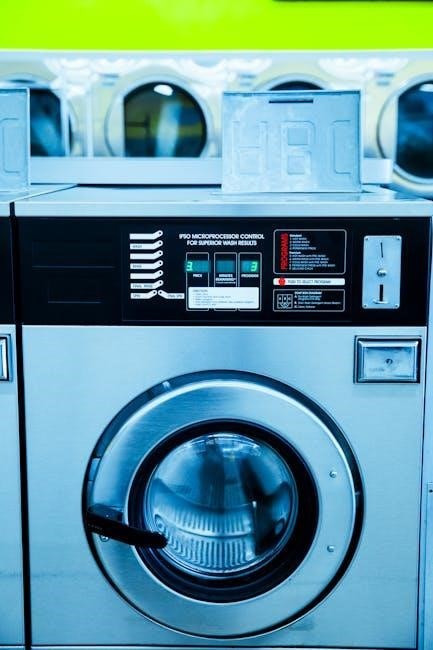pressure washer manuals
Pressure Washer Manuals: A Comprehensive Guide
Pressure washer manuals are essential resources. They provide crucial safety guidelines. They detail operating procedures. They offer maintenance tips. Manuals also include troubleshooting steps. They help users understand specifications. They aid in finding replacement parts, ensuring longevity and proper use.
Understanding the Importance of Pressure Washer Manuals
Pressure washer manuals are indispensable companions for every user, regardless of their experience level. These manuals serve as comprehensive guides, ensuring safe and effective operation of the equipment. They are not mere supplementary documents but critical resources that unlock the full potential of your pressure washer while minimizing risks.
The importance of these manuals stems from the inherent complexity and power of pressure washers. These machines, capable of generating immense pressure, demand careful handling and adherence to safety protocols. Manuals provide detailed instructions on proper usage, preventing accidents and injuries. They outline potential hazards, such as the risk of high-pressure water jets causing harm to people, animals, or delicate surfaces.
Furthermore, pressure washer manuals offer invaluable insights into the machine’s functionality. They explain the purpose of each component, the optimal settings for different cleaning tasks, and the correct techniques for achieving desired results. By following the manual’s guidance, users can maximize cleaning efficiency, avoid damaging surfaces, and prolong the lifespan of their pressure washers.

In essence, pressure washer manuals are the key to unlocking a safe, efficient, and rewarding cleaning experience. They empower users to harness the power of their machines responsibly, ensuring both personal safety and the longevity of their equipment.
Locating Your Pressure Washer Manual
Finding your pressure washer manual is the first step towards safe and effective operation. The most common place to locate it is, of course, with the original packaging. When you initially purchase your pressure washer, the manual is typically included in the box alongside the unit itself and any accompanying accessories. Make sure to thoroughly check all compartments and packaging materials before discarding them.
If you’ve misplaced the physical copy, don’t worry! Many manufacturers now offer digital versions of their manuals on their websites. Visit the manufacturer’s website and navigate to the “Support” or “Downloads” section. You’ll likely need to know the model number of your pressure washer, which can usually be found on a sticker or plate attached to the unit.
Once you’ve located the manual online, you can download it as a PDF file. This allows you to access it on your computer, tablet, or smartphone whenever you need it. Consider saving it to a cloud storage service like Google Drive or Dropbox for easy access from any device.
Another option is to search for the manual using online search engines. Simply type in the make and model of your pressure washer, followed by “manual” or “user guide.” You may find the manual on the manufacturer’s website or a third-party document repository.
Key Sections Typically Found in Pressure Washer Manuals
Pressure washer manuals are structured to provide comprehensive information. One critical section is the “Safety Precautions,” detailing potential hazards. This section outlines risks like high-pressure spray injuries. It emphasizes protective gear and safe operating distances. Understanding these guidelines is crucial for preventing accidents.
The “Operating Instructions” offer a step-by-step guide. It includes setup, starting, and shutdown procedures. This section explains nozzle selection and pressure adjustment. Proper operation extends the washer’s lifespan.
“Maintenance and Storage Tips” are vital for long-term performance. This section covers cleaning, filter maintenance, and pump care. It advises on proper storage to prevent damage from freezing or corrosion. Regular maintenance ensures efficient operation.

“Troubleshooting” helps resolve common issues. It addresses problems like low pressure or starting difficulties. This section provides diagnostic steps and potential solutions. It can save time and money on repairs.
“Specifications” provide technical details. This includes pressure ratings (PSI), flow rates (GPM), and power requirements. Understanding these specifications helps users select the right washer for their needs.
“Parts and Accessories” lists compatible components. It includes replacement nozzles, hoses, and wands. Knowing the correct parts ensures proper function.
Careful review ensures safe and effective use.
Safety Precautions and Guidelines
Pressure washers, while effective cleaning tools, demand strict adherence to safety protocols. The high-pressure water jet poses significant risks. Never direct the spray towards people, animals, or plants. Such misuse can cause severe injury or damage. Always wear appropriate personal protective equipment (PPE). This includes safety goggles, gloves, and closed-toe shoes.

Before each use, inspect the pressure washer for damage. Check hoses, connections, and the power cord. Replace any worn or damaged parts immediately. Ensure all connections are secure to prevent leaks.
When operating a pressure washer, maintain a safe distance from the cleaning surface. Start with a low-pressure setting and gradually increase as needed. Avoid spraying electrical components or outlets. Water and electricity create a dangerous combination.
Never leave a pressure washer unattended while it’s running. Children and pets should be kept away from the work area. After use, release the pressure in the hose and turn off the machine. Store the pressure washer in a safe, dry place.
Read the pressure washer manual thoroughly. Understand all safety warnings and operating instructions. Proper training and awareness are crucial for safe operation. Ignoring these guidelines can lead to accidents and injuries. Following them ensures a safe cleaning experience;
Operating Instructions: A Step-by-Step Guide
Operating a pressure washer effectively requires following a systematic approach. First, connect the water supply hose to the pressure washer’s inlet. Ensure the hose is securely attached to prevent leaks. Next, connect the high-pressure hose to the pressure washer and the spray gun. Tighten all connections to avoid water spraying from loose fittings.
Before starting the engine, attach the desired nozzle to the spray gun. Different nozzles provide varying spray patterns and pressures. Select the appropriate nozzle for the cleaning task. Then, turn on the water supply to the pressure washer.
If using a gas-powered pressure washer, ensure the engine has sufficient fuel and oil. Start the engine according to the manufacturer’s instructions. For electric models, plug the power cord into a grounded outlet.
Point the spray gun at the surface to be cleaned and squeeze the trigger. Begin with a wide spray pattern and gradually move closer as needed. Maintain a consistent distance from the surface to avoid damage. Overlap each pass to ensure thorough cleaning.
When finished, release the trigger and turn off the engine or unplug the electric model. Disconnect the hoses and store the pressure washer properly. Following these steps ensures safe and efficient pressure washer operation.
Maintenance and Storage Tips
Proper maintenance and storage are crucial for extending the life of your pressure washer. After each use, disconnect the hoses and drain any remaining water from the pump and hoses. This prevents freezing and potential damage during cold weather. Rinse the nozzles to remove any debris or buildup.
Periodically inspect the hoses for cracks, leaks, or damage. Replace any damaged hoses immediately to prevent accidents. Check the spray gun and wand for clogs or obstructions. Clean them with a small brush or needle. For gas-powered models, change the engine oil according to the manufacturer’s recommendations.
Before storing the pressure washer, add pump protector to prevent corrosion and freezing. This is especially important in colder climates. Store the pressure washer in a clean, dry place away from direct sunlight and extreme temperatures. Cover the pressure washer to protect it from dust and dirt.
If storing the pressure washer for an extended period, disconnect the spark plug wire on gas models to prevent accidental starting. For electric models, unplug the power cord. By following these maintenance and storage tips, you can ensure your pressure washer remains in optimal condition for years to come.

Troubleshooting Common Issues
Pressure washers, while reliable, can sometimes encounter issues. If your pressure washer fails to start, first check the power source or fuel level. Ensure the power switch is on or that there’s enough gasoline. Inspect the spark plug if it’s a gas model and clean or replace it if necessary.
If the pressure is weak, examine the nozzles for clogs. A blocked nozzle can significantly reduce pressure. Also, check the water inlet filter for debris. A dirty filter restricts water flow. Look for leaks in the hoses or connections. Leaks can cause a drop in pressure.
For pulsating pressure, air might be trapped in the pump. Try running the pressure washer with the nozzle removed to purge the air. If the pump is making unusual noises, it could indicate cavitation. Ensure a sufficient water supply to the pump. Overheating can also cause problems. Let the pressure washer cool down before further use.
If the engine stalls frequently, the carburetor might be dirty. Consider cleaning or rebuilding the carburetor. By systematically troubleshooting these common issues, you can often resolve problems and avoid costly repairs. Always consult the manual for specific guidance.
Understanding Pressure Washer Specifications
Pressure washer specifications are key to selecting the right model. The most important specifications include pressure, measured in pounds per square inch (PSI), and flow rate, measured in gallons per minute (GPM). PSI indicates the cleaning power. GPM indicates the volume of water delivered.
Multiply PSI and GPM to get cleaning units (CU). CU provides a single number to compare overall cleaning performance. Nozzle types also affect cleaning performance. Different nozzles create different spray patterns. These patterns are suitable for various tasks.
Electric pressure washers typically have lower PSI and GPM than gas models. Gas pressure washers are more powerful but require more maintenance. Consider the power source based on your needs. Hose length is another important specification. A longer hose allows for greater reach.
Weight and portability affect ease of use. Consider models with wheels for easy maneuverability. Also, note the maximum water inlet temperature. Exceeding this temperature can damage the pump. Understanding these specifications will help you make an informed decision. Always refer to the manual for detailed specifications.
Finding Replacement Parts and Accessories
Locating replacement parts and accessories is crucial for maintaining your pressure washer. The owner’s manual is your primary resource. It lists compatible parts and their part numbers. Always start by consulting the manual. This ensures you order the correct components.
Many manufacturers have online stores. These stores offer a wide selection of parts and accessories. Use the part number from your manual to search for specific items. Authorized dealers are another reliable source. They can provide expert advice and genuine parts.
Online marketplaces also sell pressure washer parts. However, verify the seller’s reputation before purchasing. Ensure the parts are compatible with your model. Common replacement parts include nozzles, hoses, and pumps. Accessories can enhance the washer’s functionality. Consider items like surface cleaners and extension wands.
When ordering, double-check the part number and description. Compare them to the information in your manual. Proper maintenance extends the life of your pressure washer. Using the correct parts is essential. Always follow the manufacturer’s recommendations. This guarantees optimal performance and safety.